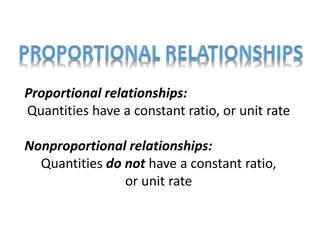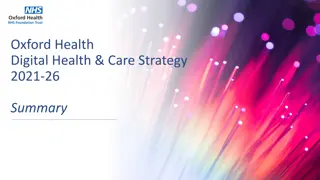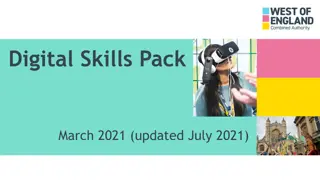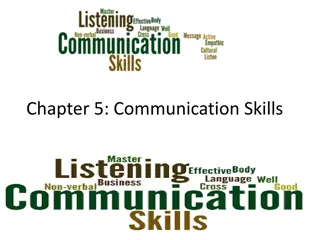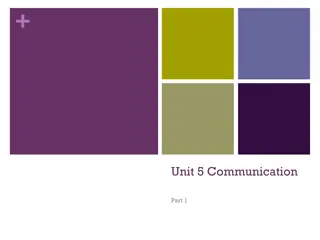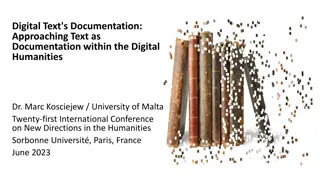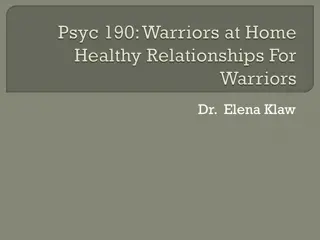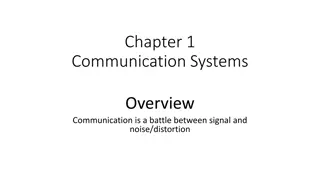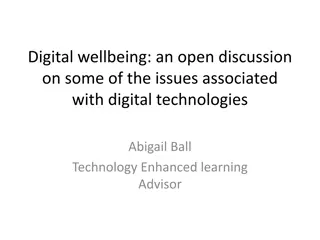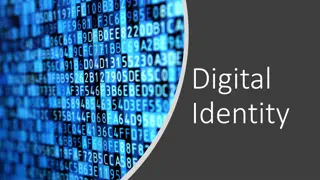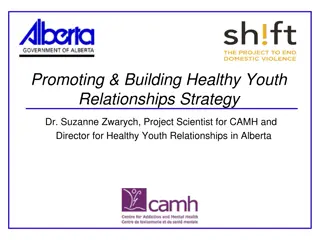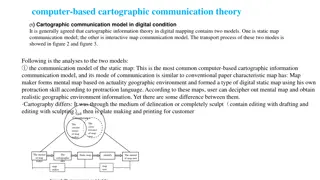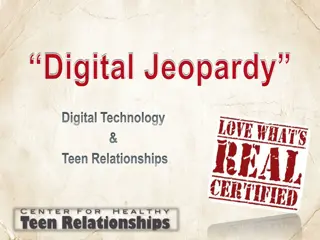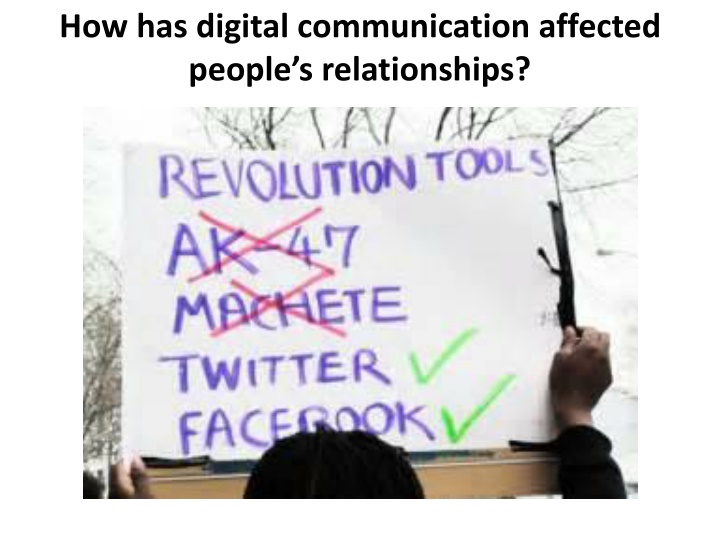
Impact of Digital Communication on Relationships
Digital communication has significantly influenced human relationships, leading to both positive and negative effects. Explore how the shift to online interactions has reshaped social ties and affected the strength of connections. Discover insights from sociologists and consider the nuances of alone together dynamics as highlighted by Sherry Turkle. Delve into the evolution of relationships via digital forms, including the emergence of weak ties and the importance of measuring relationship quality beyond mere friend counts. Examine the broader implications of digital communication on the relational landscape, weighing its advantages and drawbacks.
Download Presentation

Please find below an Image/Link to download the presentation.
The content on the website is provided AS IS for your information and personal use only. It may not be sold, licensed, or shared on other websites without obtaining consent from the author. If you encounter any issues during the download, it is possible that the publisher has removed the file from their server.
You are allowed to download the files provided on this website for personal or commercial use, subject to the condition that they are used lawfully. All files are the property of their respective owners.
The content on the website is provided AS IS for your information and personal use only. It may not be sold, licensed, or shared on other websites without obtaining consent from the author.
E N D
Presentation Transcript
How has digital communication affected people s relationships?
How has digital communication affected peoples relationships? Watch Sherry Turkle s TED talk Connected but alone which is based on her book Alone Together - What does she mean by alone together - What evidence does she provide to support this?
What kind of relationships are created through digital forms of communication? Relationships consist of social ties between people. Granovetter (1973) argues that the strength of these (i.e. the strength of a relationship) can be measured by considering: 1. The length of time spent together 2. The emotional intensity of the relationship 3. The level of intimacy 4. The degree of reciprocity (how much the other person responds in a similar way back). a) Explain the impact of weak / strong ties? b) Explain why this might be a better way of measuring relationships than using the number of friends a person has (try to use the language from your methods work)
What kind of relationships are created through digital forms of communication? c) Read the information, studies and activity on pages 27-28. Draw up a list of the positive and negative effects of digital communication on relationships. Refer specifically to each sociologist in your answer. Include ideas of your own. Positive effects of digital communication on relationships Negative effects of digital communication on relationships
What kind of relationships are created through digital forms of communication? d) Write a conclusion that answers the question Digital communication has had a mostly negative effect on relationships How far do you agree.
Google apologises over extremist video fears as Marks & Spencer pulls advertising M&S became the latest company to withdraw advertising from 20 March 2017 12:04pm Google has publicly apologised after the growing scandal over extremist videos on YouTube led to a series of companies pulling their adverts from the internet giant. The company has been accused of profiting from hatred following concerns that adverts are appearing alongside extremist material on its YouTube platform. Marks & Spencer yesterday became the latest company to withdraw its adverts from Google, following in the footsteps of the likes of McDonald s, L Oreal and the BBC. It emerged at the weekend that high street banks HSBC, Royal Bank of Scotland and Lloyds have also stopped advertising with Google, which has been ordered by the Government to explain why taxpayer-funded adverts are appearing on extremist content. Speaking at Advertising Week Europe in London, Google s European chief Matt Brittin said: I would like to apologise to our partners and advertisers who might have been affected by their ads appearing on controversial content. We take our responsibilities to these industry issues very seriously. Mr Brittin said Google will raise the bar on what is considered safe content on videos and websites. He added that the company is looking at changing the controls available to advertisers in order to make it easier for them to manage where their adverts appear, and he vowed that more money will be invested in enforcing its advertising policies. We have a review under way on how we can improve, he said. We are accelerating that review. Google reviews content once it has been flagged as inappropriate by its users, and says about 98 per cent of flagged content on YouTube is examined within 24 hours. We can do even more here, said Mr Brittin, who added that the company s reviewing process works well in the vast majority of cases . However, he failed to say whether the company would now employ staff to proactively seek out inappropriate content, rather than waiting for it to be flagged by users. The company says that 400 hours of video content is uploaded to YouTube every minute, making it hard to continuously monitor the platform. Phil Smith, director general of ISBA the voice of British advertisers, "Google s response to these brand safety issues is welcome but let us be clear it has not gone far enough. "More needs to be done to protect responsible brands advertising on Google s platforms. Advertisers should be able to use these channels without any fear that their advertisements will appear against inappropriate content. If Google is concerned that advertisers need to be educated about the intricacies of its tools, it begs the question of why they are so complex; we would ask for controls to be as simple and accessible as possible." An investigation by the Times has raised fears that advertising spending is finding its way into the hands of rape apologists, anti-Semites and hate preachers through commercials on the video sharing site. Those adverts earn the poster of the video around 6 for every 1,000 views it generates. Advertising giant Havas has also suspended its advertising, while agency GroupM, which is part of the world s largest advertising agency WPP, had urged Google to apologise. A Marks & Spencer spokesman said: In order to ensure brand safety, we are pausing activity across Google platforms whilst the matter is worked through. Audi, Tesco and Sainsbury s are among the other big advertisers to take similar steps, while Sky said it is clearly unacceptable for ads to be appearing alongside inappropriate content .
Digital communication Conflict and Change Use the studies from Howard and the Radio Free Europe article What do these suggest about the ways in which new digital communication are used by extremist groups Why has digital communication enabled this?
Social movements and new social media Reasons why new forms of social media are able to mobilise change: Immediate communication with others which can warn them / prepare them of an occurrence Information can reach huge number of people simultaneously Information about, for example, human rights abuses can be shared anonymously Groups or individuals who are usually unable to speak out or act through conventional means are able to speak to a wide range of people through digital forms of communication. For example women in countries where it is forbidden for them to speak out publically, such as in Syria News presented about events that may be inaccurate or biased can be actively challenged and possible changed Where political activism is suppressed, digital communication offers a way for people to speak out against the regime.
The Facebook Effect David Kirkpatrick Oscar Morales was fed up. It was holiday time in his hometown of Barranquilla, Colombia, just after the 2008 new year. The gentle-spirited civil engineer with a gift for computers was spending his days at the bucolic nearby beaches with his extended family. But despite the holidays, like much of the country his thoughts were dark, and occupied with the suffering of a little boy named Emmanuel. Emmanuel was the four-year-old son of Clara Rojas, who had been a hostage in the jungles of Colombia for six years. Her son had been born while she was held by the guerrillas of the Revolutionary Armed Forces of Colombia, known by its Spanish initials, FARC. FARC held a total of seven hundred hostages, including Colombian presidential candidate Ingrid Betancourt, kidnapped along with Rojas during the 2002 campaign. Sympathy and sadness about the plight of FARC s hostages was an ever-present fact in contemporary Colombia, as was fear about what the powerful and murderous revolutionary army might do next to disrupt the country. But the case of Emmanuel had lately acquired outsized prominence in the popular press. For some time President Hugo Chavez of neighboring Venezuela had been attempting to negotiate with FARC about releasing Betancourt and others. Then abruptly in late December the guerrillas announced that they would soon turn over Rojas, her son Emmanuel, and another hostage to Chavez. In a nation exhausted from a decades-long battle with the violent guerrillas, this was a rare piece of good news. People were longing for agift, for a miracle, says Morales, thirty-two. And Emmanuel was a symbol. The whole country was feeling the promise: Please let Emmanuel get his freedom. We would like that as a Christmas present from FARC. But as the new year arrived, Emmanuel still hadn t been freed. Then, in the first days of January, Colombian president Alvaro Uribe went on national television to deliver the shocking news that it appeared that Emmanuel was not even in the possession of FARC! It turned out Emmanuel had become seriously ill some time earlier, and FARC had taken him away from his mother, Clara, and dumped him with a peasant family. He was now, unexpectedly, in the government s hands. The nation was still on holiday with plenty of time to watch the news, which was all about poor, sick, abandoned Emmanuel. Morales s politically engaged extended family, hanging out by day at the beach, debated what might happen next. People were happy because the kid was safe, but we were so expletive] angry, Morales says. Forgive me for using that word but we felt assaulted by FARC. How could they dare negotiate for the life of a kid they didn t even have? People felt this was too much. How much longer was FARC going to play with us and lie to us? Morales wanted desperately to do something. So he turned to Face-book. Though the service wasn t yet even translated into Spanish, Morales spoke fluent English, as do many educated Colombians, and had been maintaining a profile there for over a year, posting his own information in Spanish and connecting with old college and high school friends. Spending time on Facebook was already a daily ritual for him. In Facebook s search box he typed the four letters FARC and hit enter. There were no results. No groups. No activism. No outrage. Groups devoted to almost everything under the sun were common on Facebook. But when it came to FARC, the citizens of Colombia had become used to being angry but cowed. In effect, the entire country had been taken hostage, and this had been going on for decades. Morales spent a day asking himself if he was willing to go public on Facebook. He decided to take the plunge, and on the 4th created a group against FARC. It was like a therapy, he says. I had to express my anger. He wrote a short description of the group s simple purpose to stand up against FARC. A self- confessed computer addict, Morales was skilled at graphics tools, so he designed a logo in the form of a vertical version of the Colombian flag. He overlaid it with four simple pleas in capitals running down the page, each one slightly larger than the last no more kidnappings, no more lies, no more killings, no more farc. I was trying to scream like if I was in a crowd, he explains. The time had come to fight FARC. What had happened was unbearable. But what should he call his group? On Facebook it s conventional to give groups names like I bet I can find one million people who hate George Bush. But Morales didn t like such titles. They were juvenile. This was not a contest. This was serious. Yet he liked the idea of a million. A famous Spanish song is called One Million Friends. One million people against FARC? The word voices sounded more literary. One million voices against FARC Un Millon de Voces Contra Las FARC. That was it. After midnight on January 4, Morales created the group. He made it public so that any Facebook member could join. His personal network included about one hundred friends, and he invited them all. He was tired. At 3 a.m. he went to bed. .
At 9 a.m. the next morning he checked his group. Fifteen hundred people had joined already! Woooooooo!!! Morales howled in delight. This was an even better response than he had expected! That day at the beach he told his extended family about the group and asked them to invite their own Facebook friends to join. Most of them were avid Facebook users as well, and they hated FARC, too. By the time Morales returned home in the late afternoon, his group had four thousand members. That s when I said to myself, Okay, no more beach, no more going out. He was ready to get serious. I felt, Oh my God! This is what I want! A committed community around the message. A Facebook group has a wall, where members can post thoughts, as well as discussion forums that allow organized, long-lasting conversations among many members. Morales soon bonded with several people who were posting there with special vigor. They exchanged instant messaging and Skype addresses and cell-phone numbers so they could continue their conversations offline. As more and more Colombians joined the group, members started talking not only about how mad they were about FARC, but what they ought to do about it. On January 6, just the second full day, a consensus on the page was emerging that the burgeoning group should go public. By the time it hit eight thousand members, people were posting on the discussion board, over and over, Let s DO something. Late on the afternoon of the 6th, his newfound Facebook friends, especially two he was speaking to by phone, convinced Morales that he should propose a demonstration. When he did, the idea was received on the wall and discussion board by acclamation. By the end of the day the group, still operating only out of Morales s upstairs bedroom, had decided to stage a national march against FARC. It would be February 4, one month after the formation of the group. Morales, who was used to being left out of things since he lived in a provincial city, insisted the march take place not only in Bogota, the capital, but also many other places throughout the country, including of course his hometown of Barranquilla. So Morales created an event called the National March against FARC. He and his co-organizers, several of them already as consumed by the project as he was, immediately got pushback from unexpected quarters. Members in Miami, Buenos Aires, Madrid, Los Angeles, Paris, and elsewhere argued that it should be a global demonstration. Morales didn t even realize people living outside Colombia had joined the group. These Colombian migr s were on Facebook partly to stay in touch with things back at home. They wanted to be involved in this movement, too. So it became a global march. What ensued was one of the most extraordinary examples of digitally fueled activism the world has ever seen. On February 4, about 10 million people marched against FARC in hundreds of cities in Colombia according to Colombian press estimates. As many as 2 million more marched in cities around the world. The movement that began with an impassioned midnight Facebook post in one frustrated young man s bedroom led to one of the largest demonstrations ever, anywhere in the world. Facebook s very newness helped Morales s demonstration garner attention in Colombia. Though several hundred thousand Colombians were already using Facebook, it had not appeared on the radar of the average citizen. So when the press began covering plans for the upcoming demonstration, its stories focused heavily on the astonishing impact of this strange American import and the Facebook kids, as many articles and TV and radio programs called them. Though Morales and his co-organizers were mostly in their early thirties, the country was also captivated by the possibility that younger people were not cowed by FARC. Once Colombian president Alvaro Uribe and Colombia s political establishment saw this Facebook uprising emerge, they did everything they could to make it a success. After a week or two the local army commander began providing Morales with three bodyguards and a car, which he used through February 4. Mayors and city governments throughout the country worked closely with demonstration volunteers to grant march permits. But what remains remarkable is the way so many Colombians on Facebook signed up on the group under their real names. By the day of the march there were 350,000. Despite decades of fear and intimidation, Facebook gave Colombia s young people an easy, digital way to feel comfort in numbers to declare their disgust. Even after news about the march had become a daily drumbeat in the press and the website had turned into a key promotional tool, Face-book remained central. Facebook was our headquarters, says Morales. It was the newspaper. It was the central command. It was the laboratory everything. Facebook was all that, right up until the last day.
Morales himself had volunteered to coordinate the local demonstration in Barranquilla. He expected about 50,000 people to show up. In fact 300,000 did, about 15 percent of the city s population. They filled more than ten city blocks. At exactly noon, Morales read a statement that the group had jointly agreed upon. It was broadcast on television all over Latin America. Demonstrators gathered even in remote places like Dubai, Sydney, and Tokyo. On local TV news, one woman was interviewed in the crush of the Bogota march. Had she been personally injured by FARC, the interviewer asked? Yes, because I am Colombian, she replied. Morales and his group members had tapped into frustrations deep in the collective national psyche. While pressure from President Uribe has played a major role in weakening FARC, the demonstrations seem to have struck their own blow. In a sign that the guerrillas were acutely aware of the impending march, on the Saturday before it took place they announced that they would release three hostages, all former Colombian congressmen, as a humanitarian gesture. Ingrid Betancourt and fourteen other hostages were rescued in a commando operation by the Colombian army in July 2008. In interviews she recalled listening to a radio in the jungle on February 4, surrounded by her FARC captors. She said she was deeply moved when she heard the demonstrators chanting in unison, No more FARC! Freedom! Freedom! Then the guerrillas couldn t stand it and turned off the radio. Oscar Morales is telling me about this in a coffee shop in Manhattan in late 2008. As he does, his voice catches. Tears well up. His group and the subsequent demonstration made him into a national and international celebrity. But the conviction and concern that fueled his creation of Un Millon de Voces Contra Las FARC remains alive. Today he devotes his entire life to the anti-FARC crusade. Though Facebook was not designed as a political tool, its creators observed early on that it had peculiar potential. During the first few weeks after it was created at Harvard University in 2004, students began broadcasting their political opinions by replacing their profile picture with a block of text that included a political statement. People were using it back then to protest whatever was important, says Facebook co-founder Dustin Moskovitz. Even if they were just upset about a minor issue with the school. People from the beginning intuitively realized that if this service was intended as a way for them to reflect online their genuine identity, then an element of that identity was their views and passions about the issues of the day. The Colombia thing, says Mark Zuckerberg, Facebook s founder, is a very early indicator that governance is changing [and of how] powerful political organizations can form. These things can really affect peoples liberties and freedom, which is kind of the point of government. . . . In fifteen years maybe there will be things like what happened in Colombia almost every day. Now, two years after Morales s stunning success, one can find Facebook-fueled activism and protest in every country and community where the service has caught on and that is pretty much all of them in the developed world. Facebook, along with Twitter, famously played a role in the revolt against the outcome of the mid-2009 elections in Iran. As New York Times foreign affairs columnist Tom Friedman pointed out, For the first time, the moderates, who were always stranded between authoritarian regimes that had all the powers of the state and Islamists who had all the powers of the mosque, now have their own place to come together and project power: the network. It was on Face-book that defeated Iranian presidential candidate Mir Hossein Mousavi told his followers when he thought it was time for them to go into the streets. And when a young woman was tragically killed during one of those protests, it was on Facebook that video of her murder emerged, to be shared worldwide as a symbol of Iranian government repression. The Iranian government, embarrassed, tried several times to shut off access to Facebook. But it is used so widely in the country that it was difficult to do so. How could Colombia s anti-FARC movement go from A to Z from one man in his bedroom to millions in the streets so quickly? Why should Facebook turn out to be a uniquely effective tool for political organizing? How did founder Zuckerberg s decisions at crucial moments in the company s history increase its impact? And in what ways do its unprecedented qualities help explain the rapidity with which Facebook has become a routine part of the lives of hundreds of millions of people around the world? As the rest of this book will explore, many of the answers lie in a set of phenomena I call the Facebook Effect. As a fundamentally new form of communication, Facebook leads to fundamentally new interpersonal and social effects. The Facebook Effect happens when the service puts people in touch with each other, often unexpectedly, about a common experience, interest, problem, or cause. This can happen at a small or large scale from a group of two or three friends or a family, to millions, as in Colombia. Facebook s software makes information viral. Ideas on Facebook have the ability to rush through groups and make many people aware of something almost simultaneously, spreading from one person to another and on to many with unique ease like a virus, or meme. You can send messages to other people even if you re not explicitly trying to. It s how Un Millon de Voces Contra Las FARC grew so fast from its very first night.
Any member who joined was merely making a statement about himself Yes, I am against FARC. A new member was not necessarily saying send this information to my friends, he was just joining the group. But as each new person joined, Facebook took that information and distributed it to the News Feeds of that person s friends. Then when those people joined the group, Facebook reported that news to their friends News Feeds. Something like Morales s anti- FARC campaign that taps into a latent need or desire can spread virally with lightning speed, making groups huge overnight. Large-scale broadcast of information was formerly the province of electronic media radio and television. But the Facebook Effect in cases like Colombia or Iran means ordinary individuals are initiating the broadcast. You don t have to know anything special or have any particular skills. Twitter is another service with a more limited range of functions that can also enable powerful broadcasting over the Internet by any individual. It too has had significant political impact. This all may be either a constructive or a destructive force. Face-book is giving individuals in societies across the world more power relative to social institutions, and that may well lead to very disruptive changes. In some societies it may destabilize institutions many of us would rather stay the same. But it also holds the promise as is starting to be shown in Egypt, Indonesia, and elsewhere of posing challenges to long-standing repressive state institutions and practices. Facebook makes it easier for people to organize themselves. How does the example of the anti-FARC movement in South America reflect these reasons.
Conflict and change The Arab Spring Watch Ghonim s ted talk read pages 30-31 What does the example of the Arab Spring suggest about the role of social media in new social movements.
Does digital communication lead to cultural homogenisation or cultural defence? Using the information provided by your colleagues. Write a summary of this argument. Try to use 8 specific sociological concepts.





